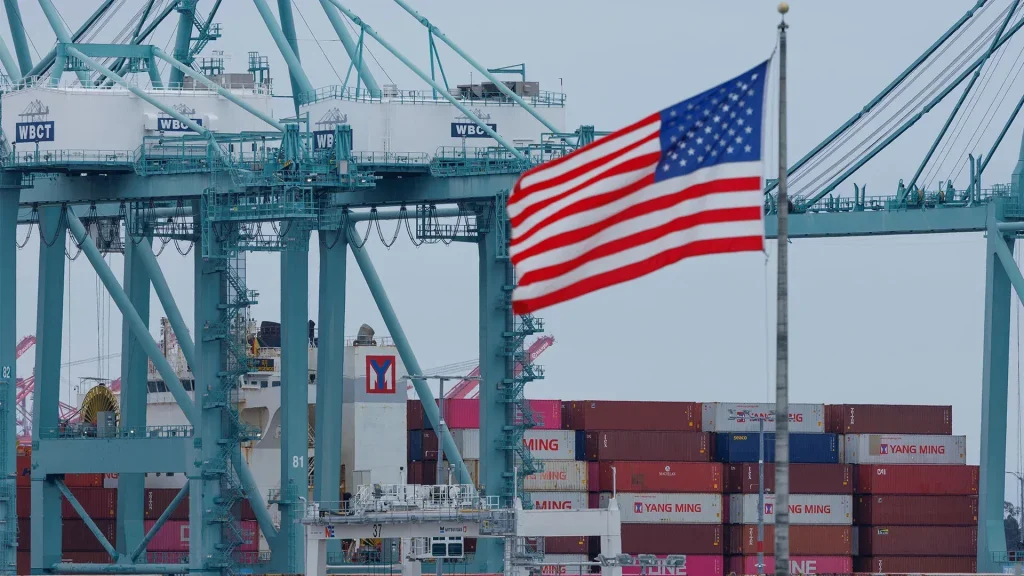Trump’s tariffs on Canada have emerged as a focal point in the ongoing debate over trade relations between the two countries. Recently, the U.S. President raised the tariff rates on Canadian goods not covered by the Canada-United States-Mexico Agreement, asserting that Canada must “pay a fair rate” in light of alleged issues with drug smuggling. However, the economic impact of these tariffs is yet to be fully realized, and the legality of such measures is under scrutiny from the courts. Many experts are questioning whether the tariffs, imposed under a claimed national emergency, will withstand legal challenges, particularly given the U.S. Constitution’s stipulations regarding trade powers. With uncertainties swirling around the Supreme Court’s potential involvement, the future of Trump’s tariffs on Canada hangs in the balance, raising concerns for both nations navigating a complex economic landscape.
The recent implementation of heightened trade duties by the Trump administration on Canadian imports marks a significant escalation in the Canada United States trade rivalry. Dubbed as necessary by President Trump to address perceived economic imbalances, these national emergency tariffs are currently being challenged in court, raising critical questions about their legitimacy and long-term viability. As discussions intensify regarding tariff rates, many are observing the potential repercussions of these economic policies on both American and Canadian markets. With inflation fears looming in the U.S. and the interconnectedness of the two economies, the ramifications of these trade decisions may spur changes at an unexpected pace. As the legal discourse unfolds, the fate of these tariffs will likely continue to provoke debate among policymakers and economists alike.
The Legal Challenges of Trump’s Tariffs on Canada
As the legality of Trump’s tariffs on Canada hangs in the balance, questions arise regarding executive power and the reach of the International Emergency Economic Powers Act (IEEPA). Critics argue that the act was not intended to be used to impose tariffs, which traditionally lie within the legislative purview of Congress. The Federal Circuit Court of Appeals is currently assessing whether Trump’s emergency claims hold any legal weight, especially considering the constitutional framework governing trade. If the courts find the tariffs unlawful, it could set a significant precedent affecting future economic policies.
This legal battle underscores the tension between the executive branch and congressional authority over trade matters. Arguments against the tariffs cite the lack of substantial evidence linking Canadian exports to the issues Trump attributes to them, particularly the thin connection to drug smuggling. If the Federal Circuit rules against the administration, it may spark further challenges and even prompt a Supreme Court ruling on the extent of presidential power under the IEEPA.
Economic Implications of Higher Tariff Rates
The increase in tariff rates on Canadian goods has raised alarms about the potential economic repercussions. While the Trump administration asserts that these tariffs will rectify unfair trade practices, the reality is that American consumers may soon feel the brunt of higher prices, which could stifle economic growth. Economists anticipate that as tariffs inflate costs for Canadian imports, retailers and consumers alike will experience spikes in prices. This inflation could lead to significant pushback from voters, particularly as economic uncertainty looms ahead of elections.
The broader economic impact also risks straining the already fragile U.S.-Canada trade relationship. Canada is a vital trading partner for the U.S.; therefore, tariffs disrupt not just cross-border business but also cause cascading effects on supply chains. With Canada starting from a weaker economic position, ongoing tariffs may force Canadian manufacturers to reconsider their dependence on U.S. markets, potentially resulting in long-term shifts in trade dynamics.
Public Sentiment and Political Pressure against Tariffs
Public sentiment plays a crucial role in the continuation of Trump’s tariffs on Canada. As the economic impact of these tariffs begins to ripple through American communities, pressure mounts on the government to rethink its strategy. Higher prices for everyday goods may lead to discontent among voters, especially in key swing states where the electorate is sensitive to economic changes. Recent polls indicate that voter approval ratings tend to decline when Americans perceive a negative personal impact from policy decisions.
Moreover, if rising costs trigger backlash, it may not just initiate calls for policy change but could also influence electoral outcomes. Political analysts suggest that if Trump’s tariffs lead to overt economic hardships, this could galvanize public opposition strong enough to influence mid-term elections. The interconnected nature of U.S. and Canadian economies signifies that America’s dissatisfaction with tariffs could echo through both nations.
The Role of Supreme Court in Trade Policy
The Supreme Court’s potential involvement in challenges to Trump’s tariffs could reshape future trade policies significantly. If the lower courts rule against the use of IEEPA for imposing tariffs, the Supreme Court may need to define the boundaries of executive power in relation to trade. Issues surrounding national emergency declarations and their implications for economic sanctions remain contentious, and a Supreme Court decision could establish a precedent that impacts future administrations’ ability to utilize similar powers.
Furthermore, the high court’s ruling could either reaffirm Trump’s approach or curtail presidential authority according to constitutional principles. Legal scholars emphasize that the outcomes of such cases are watched closely by economists and policy makers alike, who recognize the implications for international relations and market stability. The Supreme Court’s rulings on tariffs not only address present economic concerns but also frame the ongoing discourse surrounding trade policy and executive limitations.
The Interconnected Fate of U.S. and Canadian Economies
The adage “As Uncle Sam goes, so goes Canada” succinctly captures the deep interdependence between the U.S. and Canadian economies, especially in light of Trump’s tariffs on Canadian goods. While Canada is trying to navigate these tariffs, the overarching economic stability of the U.S. has far-reaching effects on its northern neighbor. As U.S. consumers face increased prices and potential economic slowdowns, the resulting impacts will be felt by Canadian businesses that rely heavily on exports to the U.S. market.
Experts argue that economic ties mean that any downturn in the U.S., exacerbated by tariffs, will reverberate through Canada’s economy, impacting employment, investment, and trade balance. Canada’s economic strategies must now consider the potential volatility of American economic policies, thus fostering a delicate dance of negotiations and strategy in navigating a future where tariffs could persist or be lifted.
Trade Agreements and Their Influence on Tariffs
Trade agreements like the Canada-United States-Mexico Agreement (CUSMA) play a pivotal role in shaping tariff regulations. Trump’s tariffs on Canadian goods have sparked debates about the adequacy and resilience of existing trade frameworks in responding to economic disputes. As the CUSMA incorporates provisions for dispute resolution, many are questioning how effectively it will protect Canadian interests amid unilateral tariffs imposed by the U.S.
Consequently, any considerations for modifying or renegotiating trade agreements could emerge as key talking points in both countries’ political landscapes. Policymakers are faced with the challenge of balancing national interests with international agreements intended to promote cooperative trade relations, and ongoing disputes over tariff rates expose the vulnerabilities inherent within these frameworks.
Emergency Powers and Tariff Implementation
Trump’s invocation of national emergency powers to impose tariffs has raised significant debate about the boundaries of executive authority. Critics highlight that emergency powers were primarily designed for national security and humanitarian crises, rather than for economic sanctions, putting the legitimacy of Trump’s tariffs under scrutiny. The legal basis for these tariffs is on shaky ground, and a ruling against them could undermine not only this particular policy but also set precedents for future administrations.
Moreover, the implementation of tariffs as a response to perceived threats rather than standardized economic practices raises questions about their long-term effectiveness. Understanding the implications of utilizing emergency powers for such purposes may provoke wider discussions about governmental authority and accountability in economic decision-making.
Future Trade Relations between U.S. and Canada
The current landscape of U.S.-Canada relations is fraught with uncertainty due to ongoing tariffs. Future negotiations on trade agreements will likely hinge on the outcomes of court cases and public sentiment regarding Trump’s tariffs on Canadian products. As both countries grapple with their interests amidst changing political dynamics, it becomes crucial for Canadian officials to advocate for terms that protect their economy against unilateral tariff increases.
Additionally, both countries must devise strategies that prioritize cooperative trade relations while navigating the challenges posed by tariffs. The mutual benefit derived from strong economic ties is undeniable, and as pressures mount, finding common ground will be essential for preventing further escalation of trade tensions.
Impacts of Tariffs on Key Industries
The sectors most affected by Trump’s tariffs on Canada include agriculture, manufacturing, and automotive industries. Agricultural products, in particular, face substantial tariff hikes that have led to decreased demand and strained relationships between American consumers and Canadian suppliers. The retaliatory tariffs by Canada on U.S. products further complicate matters, creating an environment of uncertainty that could deter investment in these industries.
Moreover, manufacturing and automotive sectors are at a crossroads as firms evaluate their cross-border operations amidst rising costs attributed to tariffs. With Canadian companies facing elevated expenses to import materials and components from the U.S., manufacturers may seek alternative suppliers or relocate operations to mitigate the impact. The long-term viability of key industries will depend on the evolving tariff landscape and how companies adapt to these economic pressures.
Frequently Asked Questions
What are Trump’s tariffs on Canada and how do they affect trade?
Trump’s tariffs on Canada have raised the tariff rates on certain Canadian goods not covered under the CUSMA agreement from 25 to 35 percent. These tariffs are claimed to be in response to Canada’s failure to control the influx of illicit drugs, despite data showing minimal fentanyl seizures from Canada compared to Mexico. This increase in tariffs affects Canada-United States trade by raising costs for Canadian exporters and potentially leading to higher prices for American consumers.
Are Trump’s tariffs on Canada legal under U.S. law?
The legality of Trump’s tariffs on Canada is currently in question. Critics argue that the tariffs, imposed through a national emergency declaration under the IEEPA, may exceed presidential powers as the U.S. Constitution gives Congress control over trade. A recent court case highlighted this ambiguity, with appeals judges questioning whether the IEEPA was intended to cover tariffs.
What economic impact do Trump’s tariffs on Canada have on consumers?
The economic impact of Trump’s tariffs on Canada is expected to result in higher prices for American consumers as tariff rates increase. While economists note that inflation from these tariffs has not yet been fully felt, there are fears that as prices rise, this could lead to economic uncertainty and affect consumer spending, which could ultimately influence political outcomes.
How might the Supreme Court address Trump’s tariffs on Canada?
The Supreme Court may play a pivotal role in determining the future of Trump’s tariffs on Canada if lower courts rule against their legality. The Federal Circuit Court of Appeals has raised questions regarding the constitutionality of these tariffs under the IEEPA, and if the case progresses, the Supreme Court could either choose to take it up or allow the lower court’s ruling to stand.
What could lead to a collapse of Trump’s tariffs on Canada?
Trump’s tariffs on Canada could collapse due to legal challenges questioning their constitutionality or through economic pressure from American consumers experiencing rising prices. If the Federal Circuit finds the tariffs illegal or if public backlash against increased costs impacts political support, it may compel a policy change.
How are Canada’s economic conditions influencing the response to Trump’s tariffs?
Canada’s economic conditions are significantly weaker compared to the U.S., making it more vulnerable to the effects of Trump’s tariffs. As the interconnectedness of the two economies means that a downturn in the U.S. economy could also adversely affect Canada, this disparity complicates Canada’s ability to withstand tariff pressures.
What is the role of national emergency tariffs in Trump’s trade strategy?
National emergency tariffs, like those imposed by Trump on Canada, are intended to provide the president with broad and flexible powers to regulate imports under the IEEPA. However, the justification for using these emergency powers to justify trade tariffs has faced legal challenges, questioning whether such actions are permissible for trade measures.
How might consumers push back against Trump’s tariffs on Canada?
Consumers might push back against Trump’s tariffs on Canada by expressing dissatisfaction through their purchasing choices or voting behavior. If higher prices from the tariffs lead to widespread consumer discomfort, this could create political pressure on the administration to reconsider its tariff policies.
| Key Points | Details |
|---|---|
| Tariff Increase | Trump raised tariff rates on Canadian goods from 25% to 35%. |
| Justification for Tariffs | The White House claims tariffs are due to Canada’s failure to curb drug trafficking, particularly fentanyl. |
| Legality of Tariffs | There are ongoing legal challenges questioning the constitutionality of Trump’s use of IEEPA for tariffs. |
| Economic Impact | Economic pressures could lead to higher prices for Americans, potentially influencing political outcomes. |
| Canada’s Economic Situation | Canada’s economy is in a weaker state, making it harder to withstand potential U.S. pressures. |
| Interconnected Economies | The economies of the U.S. and Canada are closely linked, meaning downturns in one affect the other. |
Summary
Trump’s tariffs on Canada represent a controversial and complex economic policy that may face substantial challenges ahead. The legality of these tariffs under U.S. law is in question due to potential overreach of presidential powers. Furthermore, the anticipated economic impact, with rising prices leading to public discontent, might force a reevaluation of these measures. As both economies are interconnected, any adverse effects from Trump’s tariffs could resonate deeply within Canada, heightening the stakes for all involved.




